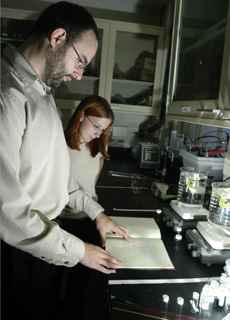Strano commended for nanotech work

Jonathan Witten
September 30, 2004
Michael Strano, a professor in the University’s Department of Chemical and Biomolecular Engineering, was named a member of the 2004 class of 100 Top Young Innovators by Technology Review (TR100) for his contribution to nanotechnology.
TR100, now in its fourth year, honors pioneers under the age of 35 for their contributions in transforming the field of technology. Technology Review, published by Massachusetts Institute of Technology, is the oldest magazine of its kind.
The 28-year-old professor was recognized for finding a method to create a group of carbon nanotubes that share a single property. Nanotubes are microscopic tubes with unique electronic and mechanical properties. Their strength makes them ideal for use in electronics and the creation of polymer materials, among other things.
Monica Usrey, a University graduate student and a member of the Strano Research Group (SRG), said it was extremely difficult to separate and group nanotubes by their specific functions.
“(Nanotubes are like) bowls of spaghetti,” Usrey said. “They like to stick together.”
Get The Daily Illini in your inbox!
Strano said it was necessary to invent new classes of carbon nanotube surface chemistry in order to group nanotubes with the same properties. He said the new technology would allow for greater flexibility and increased effectiveness of the nanotubes.
Paul Barone, also a graduate student and a member of SRG, developed a prototype nanotube biosensor based on a new invention that measures the glucose level in the bloodstream of diabetics.
Barone said the device, when inserted under the skin, emits infrared light that indicates the blood sugar level of the diabetic. He said the sensor, coupled with an external device that would detect and interpret the infrared light, would greatly decrease the hassles of diabetics in their everyday lives.
“You don’t have to continually (prick) yourself,” Barone said. “Any time you want to know (the blood sugar level) you can monitor your glucose level. It’s simple and easy.”
Strano also said the research group had engineered prototype “gas sensors” that, using his new nanotube technology, can detect chemical and biological agents. The project of developing the gas sensors is sponsored by the Defense Advanced Research Projects Agency, a research and development organization of the Department of Defense. He said the microscopic size of these sensors would prove to be very effective in detecting nerve agents such as sarin gas.
“They can protect against chemical terrorism just by sheer numbers,” he said.
Jonathan Higdon, professor of the Department of Chemical and Biomolecular Engineering, said Strano’s experience as a post-doctoral fellow under Richard Smalley, a 1996 Nobel Laureate for his work on carbon nanotubes, was a telling sign of Strano’s future success.
“We were impressed by the novelty of his research,” Higden said as he recalled the time Strano was first interviewed by the department. “Based on the caliber of his research with Smalley, we had great expectations with his research.”
Barone said Strano’s mental capacity was what set him apart from others.
“He has so much going on in his head that we have to try very hard just to keep up,” he said.
Usrey said people who knew Strano would not be surprised by his success.
“(Science) is his passion. He’s also very good at it,” she said.
Strano appreciated the recognition, but remained focused on his craft.
“There’s a tremendous amount of work to be done. The story does not end,” he said. “It’s great to be recognized, but there’s more to do.”






